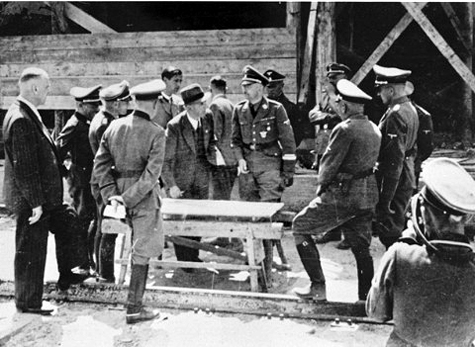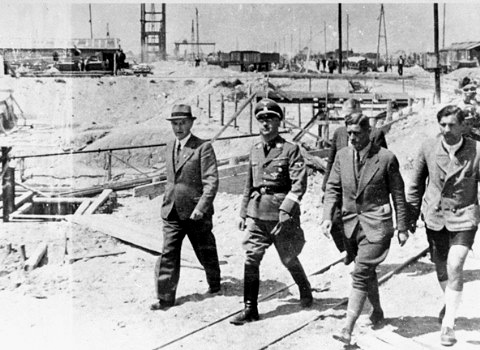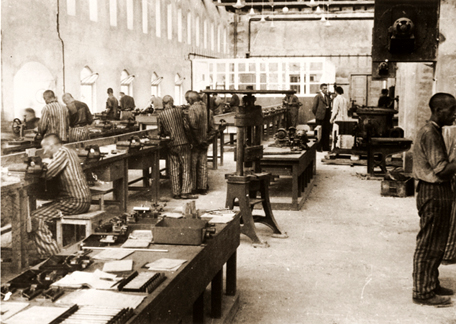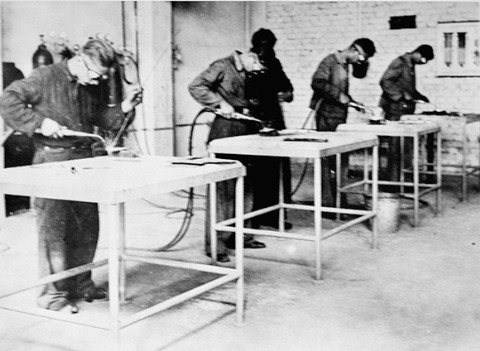Auschwitz III - Monowitz |
||
|

Auschwitz III - Monowitz |
||
|

|
Auschwitz III, aka Monowitz, was established in 1942 at the site of the chemical factories of IG Farbenindustrie near the small village of Monowitz, which was located four kilometers from the town of Auschwitz. The IG Farben company had independently selected this location around the same time that Reichsführer-SS Heinrich Himmler decided, in April 1940, to locate a new concentration camp in the town of Auschwitz. The most important factory at Monowitz was the Buna Werke, which was owned by the IG Farben company. Of the three Nazi concentration camps located near the town of Auschwitz, the Auschwitz III camp was the most important to the Nazis because of its factories which were essential to the German war effort. The Monowitz industrial complex was built by Auschwitz inmates, beginning in April 1941. Initially, the workers walked from the Auschwitz main camp to the building site, a distance of seven kilometers. The decision to build chemical factories at Auschwitz transformed both the camp and the town. On February 2, 1941, Herman Göring ordered the Jews in the town to be relocated to a ghetto, and German civilians moved into their former homes. Auschwitz quickly went from a primitive Jewish town of 12,000 inhabitants to a modern German town of 40,000 people which included an influx of German engineers and their families. Both the main Auschwitz camp and the Birkenau camp were expanded in order to provide workers for the factories. Before Monowitz became a separate camp with barracks buildings, the prisoners had to walk from the other camps to the factories. On July 17 and 18, 1942, Reichsführer-SS Heinrich Himmler made a visit to the Auschwitz complex. The photo at the top of this page shows Himmler talking with German engineer Max Faust about plans for factories at Monowitz, the Auschwitz III camp.  The photograph above shows Reichsführer-SS Heinrich Himmler, a five-star general who was the head of the SS and the man who was responsible for all the Nazi concentration camps, on a visit to inspect the Monowitz factories on July 17th and 18th, 1942. Himmler is the man wearing a uniform. The two men on the right are German engineers. The engineers lived in the town of Auschwitz, after it was cleaned up to meet German standards of living. Slave labor was used to make improvements to the town, after Himmler volunteered the services of the concentration camp inmates. The Jews who were sent to Auschwitz, and then assigned to work at Monowitz, had a much better chance of survival because the factory workers were considered too valuable to send to the gas chambers, at least while they were still able to work. Two famous survivors who worked at Monowitz were Elie Wiesel and Primo Levi, both of whom wrote extensively about the Holocaust.  In the photograph above, Himmler is on the far right; the man in civilian clothes, who is shaking hands, is Max Faust. The barracks for the prisoners are shown in the background; the slave workers from Auschwitz were transferred to the Monowitz barracks at the end of October 1942. The factories at Monowitz were built by the I.G. Farben company, which was attempting to produce synthetic rubber, called Buna. The Polish village of Monowice, which was called Monowitz by the Germans, is located 4 kilometers from the site of the factories, which were on the east side of the town of Auschwitz. Some of the old factory buildings are still standing, although now abandoned, while others are still in use as factories. The concrete wall around the factories, with its distinctive curved posts strung with barbed wire, can still be seen along the road from Auschwitz to the Krakow airport. Because of its central location in Europe at a major railroad junction, and the abundance of coal and other raw materials in the area, Auschwitz became an important location for German industry after Upper Silesia was incorporated into the Greater German Reich in 1939. Between 1942 and 1945, a network of 40 satellite camps was established in a wide area around Auschwitz. Some of these camps were administered by the Auschwitz III camp at Monowitz, but most were administered by the Auschwitz Stammlager as the main camp was called. There were three categories of satellite camps: Aussenlager (external camp), Nebenlager (extension or sub-camp) or Arbeitslager (labor camp). Twenty-eight of these 40 satellite camps of Auschwitz were part of the German armaments industry.  The photo above was taken in 1944 at the Bobrek sub-camp of Auschwitz. It shows Jewish prisoners working in an airplane factory called Siemens Schuckert Werke. In the background, the man wearing a civilian suit is Herr Jungdorf, a German engineer for the Siemens company. The Monowitz sub-camp was known as Bunalager (Buna Camp) until November 1943 when it became the Auschwitz III camp with its own administrative headquarters. Auschwitz III consisted of 28 sub-camps which were built between 1942 and 1944. This area of Upper Silesia was known as the "Black Triangle" because of its coal deposits. The Buna plant attracted the attention of the Allies, and there were several bombing raids on the factories.  The following quote is from an article written by Edwin Black, the author of "IBM and the Holocaust": Central to the Nazi effort was a massive 500-man Hollerith Gruppe, installed in a looming brown building at 24 Murnerstrasse in Krakow. The Hollerith Gruppe of the Nazi Statistical Office crunched all the numbers of plunder and genocide that allowed the Nazis to systematically starve the Jews, meter them out of the ghettos and then transport them to either work camps or death camps. The trains running to Auschwitz were tracked by a special guarded IBM customer site facility at 22 Pawia in Krakow. The millions of punch cards the Nazis in Poland required were obtained exclusively from IBM, including one company print shop at 6 Rymarska Street across the street from the Warsaw Ghetto. The entire Polish subsidiary was overseen by an IBM administrative facility at 24 Kreuz in Warsaw. The exact address and equipment arrays of the key IBM offices and customer sites in Nazi-occupied Poland have been discovered. But no one has ever been able to locate an IBM facility at, or even near, Auschwitz. Until now. Auschwitz chief archivist Piotr Setkiewicz finally pinpointed the first such IBM customer site (in 2002). The newly unearthed IBM customer site was a huge Hollerith Büro. It was situated in the I.G. Farben factory complex, housed in Barracks 18, next to German Civil Worker Camp 7, about two kilometers from Auschwitz III, also known as Monowitz Concentration Camp. Auschwitz' Setkiewicz explains, "The Hollerith office at IG Farben in Monowitz used the IBM machines as a system of computerization of civil and slave labor resources. This gave Farben the opportunity to identify people with certain skills, primarily skills needed for the construction of certain buildings in Monowitz." The Monowitz camp was kept open until just a week before soldiers in the army of the Soviet Union arrived to liberate the camp. The last roll call of the three Auschwitz camps showed a total of 67,012 prisoners. Out of this total, more than half were the workers in the Buna plant at Monowitz and its sub-camps. Although the Nazis were desperate for workers in their munitions factories, Hungarian Jews who were capble of working were gassed upon arrival at Auschwitz, according to Danuta Czech. The figures below are from the Nazi records which were turned over to the Red Cross by the Soviet Union after the fall of Communism. They were published in a book written by Danuta Czech. Male prisoners in Auschwitz III
Monowitz (Buna-Werke) 10,223 Female prisoners in Auschwitz III Subtotal 2,095 Total for Auschwitz III: 35,118 When I visited Auschwitz in October 1998, I was told that some of the Monowitz factories were still in operation, but this area was off limits to visitors. On my trip to Auschwitz in October 2005, I hired a taxi driver to take me to the site of the factories, but I was told that they didn't exist anymore. On my way back to the Krakow airport from Auschwitz, the taxi driver from my hotel pointed out the factory buildings, partially hidden behind the concrete wall. British POW camp near MonowitzBritish POW sneaked into Auschwitz twiceMonowitz gas chamber?Liberation of Auschwitz-BirkenauSurvivors of Birkenau campDeath StatisticsHistory of AuschwitzAuschwitz II - aka BirkenauSelections for gas chamber or laborHomeThis page was last updated on January 14, 2008 |